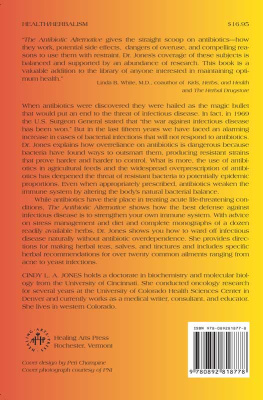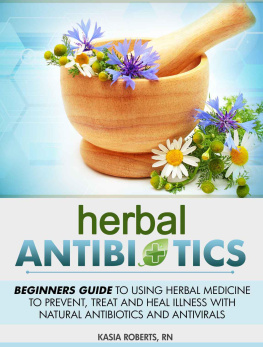OTHER BOOKS BY STEPHEN HARROD BUHNER
Ensouling Language: On the Art of Nonfiction and the Writers Life
The Fasting Path: The Way to Spiritual, Physical, and Emotional Enlightenment
Healing Lyme: Natural Healing and Prevention of Lyme Borreliosis and Its Coinfections
Herbs for Hepatitis C and the Liver
The Lost Language of Plants: The Ecological Importance of Plant Medicines for Life on Earth
The Natural Testosterone Plan
One Spirit, Many Peoples: A Manifesto for Earth Spirituality
Pine Pollen: Ancient Medicine for a Modern World
Sacred and Herbal Healing Beers: The Secrets of Ancient Fermentation
Sacred Plant Medicine: The Wisdom in Native American Herbalism
The Secret Teachings of Plants: The Intelligence of the Heart in the Direct Perception of Nature
The Taste of Wild Water: Poems and Stories Found While Walking in Woods
Vital Man: Natural Health Care for Men at Midlife
HERBAL ANTIBIOTICS
NATURAL ALTERNATIVES
FOR TREATING DRUG-RESISTANT BACTERIA
STEPHEN HARROD BUHNER

For David Hoffmann,
who began it all
The mission of Storey Publishing is to serve our customers by
publishing practical information that encourages
personal independence in harmony with the environment.
Edited by Nancy Ringer and Lisa H. Hiley
Art direction and book design by Mary Winkelman Velgos
Text production by Vicky Vaughn Shea/Ponderosa Pine Design and Jennifer Jepson Smith
Cover photography by Eric Delmar/iStockphoto.com: mortar and pestle, Kryczka/iStockphoto.com: juniper berries, and VMJones/iStockphoto.com: tincture bottle
Indexed by Nancy D. Wood
2012 by Stephen Buhner
This publication is intended to provide educational information for the reader on the covered subject. It is not intended to take the place of personalized medical counseling, diagnosis, and treatment from a trained health professional.
All rights reserved. No part of this book may be reproduced without written permission from the publisher, except by a reviewer who may quote brief passages or reproduce illustrations in a review with appropriate credits; nor may any part of this book be reproduced, stored in a retrieval system, or transmitted in any form or by any meanselectronic, mechanical, photocopying, recording, or otherwithout written permission from the publisher.
The information in this book is true and complete to the best of our knowledge. All recommendations are made without guarantee on the part of the author or Storey Publishing. The author and publisher disclaim any liability in connection with the use of this information.
Storey books are available for special premium and promotional uses and for customized editions. For further information, please call 1-800-793-9396.
Storey Publishing
210 MASS MoCA Way
North Adams, MA 01247
www.storey.com
Printed in the United States by Edwards Brothers Malloy
10 9 8 7 6 5 4 3 2 1
Library of Congress Cataloging-in-Publication Data
Buhner, Stephen Harrod.
Herbal antibiotics / by Stephen Harrod Buhner.2nd ed.
p.; cm.
Includes bibliographical references and index.
ISBN 978-1-60342-987-0 (pbk.: alk. paper)
I. Title.
[DNLM: 1. Herbal Medicinemethods. 2. Anti-Bacterial
Agentstherapeutic use. 3. Bacterial Infectionsdrug therapy.
4. Plant Preparationstherapeutic use. WB 925]
616.9201dc23
2012004609
ACKNOWLEDGMENTS
Julie McIntyre, Robert Chartier, Nikki Darrell, Rosemary Gladstar, James Duke, Kathleen Gilday, Don Babineau, Melanie and Jeff, William LaSassier, Michael Moore, Ryan Drum, James Green, Matthew Wood, Susun Weed, Naava, Candace Catin Packard, Jim McDonald, Redbird, Kevin, Eric, Erica, and of course, Buck and the boys.
FOREWORD TO THE FIRST EDITION
by James A. Duke, PhD
Stephen Buhner has arrived at (and shares with you, the reader) the frightening truth that you wont find in the Journal of the American Medical Association: We are running out of weapons in the war on germs. Since germs can go through a generation in 20 minutes or so, instead of the 20 years or so it takes us humans to reproduce ourselves, its no small wonder that the germs are evolving resistance to our chemical weapons as rapidly as we develop them.
When the drug vancomycin falls completely by the wayside, as it will, we may, just as Stephen predicts here and I have predicted elsewhere, fall back on the bimillennial biblical medicinal herbs such as garlic and onion. These herbs each contain dozens of mild antibiotic compounds (some people object to using the term antibiotic to refer to higher plant phytochemicals, but I do not share their disdain for such terminology). It is easy for a rapidly reproducing bug or bacterial species to outwit (out-evolve) a single compound by learning to break it down or even to use it in its own metabolism, but not so easy for it to outwit the complex compounds found in herbs. Scientists are recognizing this fact and developing more complex compounds such as the AIDS cocktail and multiple chemotherapies for cancer. The same super-scientists who downplay the herbalists claims of synergies that account for the effectiveness of particular herbs and herbal formulas are now resorting to synergies of three or four compounds in their pharmaceutical formulas.
It is certainly easier to demonstrate how two compounds can work synergistically than it is to figure out how 200 or 2,000 different compounds (and more, as are present in all herbs) can work synergistically. So the scientific community will be reluctant to consider the remarkable synergistic suites of compounds that have evolved naturally in plants. But we really cannot afford to ignore these. For nature favors synergies among beneficial, plant-protective compounds within a plant species (with antibacterial, antifeedant, antifungal, antiviral, and insecticidal properties) and selects against antagonisms.
When we borrow the antibiotic compounds from plants, we do better to borrow them all, not just the single solitary most powerful among them. We lose the synergy when we take out the solitary compound. But most important, we facilitate the enemy, the germ, in its ability to outwit the monochemical medicine. The polychemical synergistic mix, concentrating the powers already evolved in medicinal plants, may be our best hope for confronting drug-resistant bacteria.
The Evolution of Modern Medicine
(as imagined and adapted by Jim Duke from Internet surf castings)
8,000,000 years ago: One chimp to another: I have a tummy ache (in chimpanzeze, rubbing tummy). Response: Here, chimp, eat these bitter herbs! (in chimpanzeze).
5,000,000 years ago: Here, Hominid, eat these bitter herbs! (in hominidese).
2,500,000 years ago: Here, Homo, eat these bitter herbs and leave some for the Leakeys to find! (in homonoid sign language).
2500 BCE: Here, man, eat these bitter herbs! (in Arabic, Coptic, Farsi, Hebrew, etc.).
0 CE: The Savior is born! Faith can heal. Eat these bitter herbs (if faith should fail!).
1200 CE: Those bitter herbs arent Christian. Say a prayer when you take those bitters!
Next page




